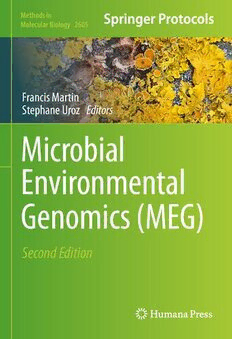
Microbial Environmental Genomics (MEG) PDF
Preview Microbial Environmental Genomics (MEG)
Methods in Molecular Biology 2605 Francis Martin Stephane Uroz Editors Microbial Environmental Genomics (MEG) Second Edition M M B ETHODS IN OLECULAR IO LO GY SeriesEditor JohnM.Walker School of Lifeand MedicalSciences University ofHertfordshire Hatfield, Hertfordshire, UK Forfurther volumes: http://www.springer.com/series/7651 For over 35 years, biological scientists have come to rely on the research protocols and methodologiesinthecriticallyacclaimedMethodsinMolecularBiologyseries.Theserieswas thefirsttointroducethestep-by-stepprotocolsapproachthathasbecomethestandardinall biomedical protocol publishing. Each protocol is provided in readily-reproducible step- by-stepfashion,openingwithanintroductoryoverview,alistofthematerialsandreagents neededtocompletetheexperiment,andfollowedbyadetailedprocedurethatissupported with a helpful notes section offering tips and tricks of the trade as well as troubleshooting advice. These hallmark features were introduced by series editor Dr. John Walker and constitutethekeyingredientineachandeveryvolumeoftheMethodsinMolecularBiology series. Tested and trusted, comprehensive and reliable, all protocols from the series are indexedinPubMed. Microbial Environmental Genomics (MEG) Second Edition Edited by Francis Martin Tree-Microbe Interact (IAM); Biogeochem, UMR1136 INRA/University of Lorraine, Labex ARB, Champenoux, France Stephane Uroz Université de Lorraine, INRAE, UMR1136 “Interactions Arbres-Microorganismes”, F-54280 Champenoux, France; INRAE, UR1138 “Biogéochimie des écosystèmes forestiers”, F-54280 Champenoux, France; INRAE, USC1371 “Labex ARBRE”, F-54280 Champenoux, France Editors FrancisMartin StephaneUroz Tree-MicrobeInteract(IAM); Universite´deLorraine,INRAE,UMR1136 Biogeochem “InteractionsArbres-Microorganismes” UMR1136INRA/University F-54280Champenoux,France ofLorraine,LabexARB INRAE,UR1138“Bioge´ochimiedes Champenoux,France e´cosyste`mesforestiers” F-54280Champenoux,France INRAE,USC1371“LabexARBRE” F-54280Champenoux,France ISSN1064-3745 ISSN1940-6029 (electronic) MethodsinMolecularBiology ISBN978-1-0716-2870-6 ISBN978-1-0716-2871-3 (eBook) https://doi.org/10.1007/978-1-0716-2871-3 ©TheEditor(s)(ifapplicable)andTheAuthor(s),underexclusivelicensetoSpringerScience+BusinessMedia,LLC,part ofSpringerNature2023 Thisworkissubjecttocopyright.AllrightsaresolelyandexclusivelylicensedbythePublisher,whetherthewholeorpart of the material is concerned, specifically the rights of translation, reprinting, reuse of illustrations, recitation, broadcasting,reproductionon microfilmsorinanyotherphysicalway,andtransmissionorinformation storageand retrieval,electronicadaptation, computersoftware,orbysimilar ordissimilar methodologynow knownorhereafter developed. Theuseofgeneraldescriptivenames,registerednames,trademarks,servicemarks,etc.inthispublicationdoesnotimply, evenintheabsenceofaspecificstatement,thatsuchnamesareexemptfromtherelevantprotectivelawsandregulations andthereforefreeforgeneraluse. Thepublisher,theauthors,andtheeditorsaresafetoassumethattheadviceandinformationinthisbookarebelievedto betrueandaccurateatthedateofpublication.Neitherthepublishernortheauthorsortheeditorsgiveawarranty, expressedorimplied,withrespecttothematerialcontainedhereinorforanyerrorsoromissionsthatmayhavebeen made.Thepublisherremainsneutralwithregardtojurisdictionalclaimsinpublishedmapsandinstitutionalaffiliations. ThisHumanaimprintispublishedbytheregisteredcompanySpringerScience+BusinessMedia,LLC,partofSpringer Nature. Theregisteredcompanyaddressis:1NewYorkPlaza,NewYork,NY10004,U.S.A. Preface While we raise the head to look at the sky to discover new planets and new stars, and potential new forms of life, we are far to have characterized the full diversity of organisms livingonEarth,theirfunctions,andtheirrelativerole.Eachyearnewspeciesarediscovered, including macro-organisms, and many scientists wonder if we may lose species before we even know that they existed. Determining the exact number of species is still a scientific challengeandparticularlyforsmall-sizemicrobiotamembers.Betheyconsideredasextreme ornot,nearlyalltheenvironmentsofourplanetareinhabitedbymicroorganisms,andmost oftheseenvironmentsallowedfortheidentificationofnewspecieswithparticularfunctions. Onemaywonderwhyitisimportanttoinventorythediversityofthebiosphere.Character- izing this biodiversity is essential as all the organisms are part of our environment and participate in ecosystem functioning, homeostasis, and in the services they provide. They also represent for many of them a fundamental part, an extension, of the macro-organism functioning.Indeed,itisnowclear thathuman,animal,orplantdevelopment;physiology; and adaptation involve their associated microbiota. By adapting to their local environment andchangingconditions,microorganismshavedevelopedparticular functionsandevolved in different ways. Characterizing this evolution through the analysis of the genomic and biochemical resources permits to investigate the continual evolution cycle, to understand thekeysteps,andtopredictscenariosaccordingtoactualandfutureenvironmentalchanges. Characterizing the functions of these microorganisms also permits to elaborate on the phenomenaofconvergentanddivergentevolutionaswellasonthefunctionalredundancy, but also on the relative role of these microorganisms and on their potential use. In the presentenvironmentalandenergetictransitionsthatarefacingoursocieties,environmental resources and microorganisms represent new options to develop environmental friendly bioprocesses and biomolecules. At the same time, it is essential to understand how these microorganismsadapttorapidlychangingconditions(i.e.,climatechange,fertilisation).It is so essential to understand who they are (i.e., taxonomic identification)? Where they are distributed(i.e.,fromsmalltolargescales)?Whattheyaredoing(i.e.,functionalcharacteri- zation)?Withwhomtheyareinteracting(i.e.,complexityintegration)?Andhowtheyadapt toglobalchanges? This bookpresentsa seriesof 17chapters to guideresearch inenvironmental microbi- ologyandgenomicstocharacterizeandimagerareorevenhithertounknowntaxaandtheir interactions, to identify new functions and biomolecules, and to understand how environ- mentalchanges(climate,nutrientavailability,drought,urbanization)conditiontheactivity and the response of the organisms living with us or/and in our environment. Methods to v vi Preface analyze the diversity of different organism types (i.e., archaea, bacteria, fungi, protest, microfauna, and microeukaryotes) are presented in Chaps. 1, 2, 3, and 4. Notably, Chap. 4 presents a combined set of methods to survey seed colonizing fungi using both traditional culture-based methods and culture-free metabarcoding. Chapters 5, 6, and 7 describe methods to produce high-quality DNA adapted to the sequencing technologies from particular fungi, complex systems, or ancient samples. Chapters 8 and 9 present methodstoinvestigatethemicrobialcommunitiesdirectlyinvolvedincomplexinteractions orprocessesthroughstableisotopeprobing(DNA-andRNA-SIP).Methodstoidentifyand characterizenewfunctionalgenesortaxonomicmarkersarepresentedinChaps.10,11,and 12.Theseincludeprotocolsforgenecapture,fosmidlibraryconstruction,andscreeningas well as the Tnseq approach. Databases and bioinformatics analysis tools are presented in Chaps. 13 and 14 (i.e., MAGE and MycoCosm). Methods to investigate complex interac- tions and image in situ interactions are presented in Chaps. 15, 16, and 17. In situ hybridization(insituFISH)methodispresentedtoimagefungalendobacteriainChap.15. By investigating the composition, function, complex interactions, and spatial distribu- tion of microbiota members in their environment, this book represents a primary research reference for scientists and lab managers in environmental microbiology working in the expanding field of environmental microbiology and genomics. The level of presentation is technicallyadvancedwithastrongemphasisondescribingcutting-edgeprotocolsinlightof thepossiblefuturedirectionsforresearch.Weanticipateinafutureedition,thepresentation of microfluidic-based protocols for high-throughput functional screening or to analyse complexinteractionsaswellastheuseofimagingmassspectrometrytovisualizethespatial distributionofmetabolitesonthesurfaceofthesamples(e.g.,bacterialor fungalcolony). Champenoux,France FrancisMartin StephaneUroz Contents Preface ..................................................................... v Contributors................................................................. ix 1 MetabarcodingApproachesforSoilEukaryotes,Protists, andMicrofauna..... ....... ........ ....... ....... ........ ....... ........ 1 GuillaumeLentendu,EnriqueLara,andStefanGeisen 2 MetabarcodingoftheThreeDomainsofLifeinAquatic SalineEcosystems.......... ........ ....... ....... ........ ....... ........ 17 DelphineMelayah,Ze´liaBontemps,MaximeBruto, Agne`sNguyen,PhilippeOger,andMyle`neHugoni 3 SamplePreparationforFungalCommunityAnalysisbyHigh-Throughput SequencingofBarcodeAmplicons ..... ..... ...... ....... .. ....... ........ 37 KarinaE.Clemmensen,KatarinaIhrmark, MikaelBrandstr¨omDurling,andBj¨ornD.Lindahl 4 CharacterizationofSeedMycobiotaUsingCulture-Dependent andCulture-IndependentApproaches....... ....... ........ ....... ........ 65 GillianE.Bergmann,SabrinaJ.Heitmann, PosyE.Busby,andJohanH.J.Leveau 5 TissueCultivation,Preparation,andExtractionofHighMolecular WeightDNAforSingle-MoleculeGenomeSequencing ofPlant-AssociatedFungi........... ....... ....... ........ ....... ........ 79 LaureFauchery,MaximKoriabine,LillianP.Moore, YukoYoshinaga,KerrieBarry,AnnegretKohler,andJanaM.U’Ren 6 AnalysisofAncientMicrobialDNA ......... ....... ........ ....... ........ 103 OlivierGorge´,E.AndrewBennett,DiyendoMassilani, JulienDaligault,Eva-MariaGeigl,andThierryGrange 7 Whole-GenomeSequencingofBacterialEndophytesFromFresh andPreservedPlantSpecimens ...... ....... ....... ........ ....... ........ 133 BramDanneelsandAure´lienCarlier 8 InvestigatingtheBacterialandFungalCommunitiesInvolved inDeadBiomassDegradationinForestSoils........ ........ ....... ........ 157 MartinaSˇtursova´,RubenL(cid:1)opez-Monde´jar,andPetrBaldrian 9 StableIsotopeProbing-RNAStrategytoStudyPlant/Fungus Interactions .... .... ....... ........ ....... ....... ........ ....... ........ 169 AmandineLeˆ Van,MarieDuhamel,AchimQuaiser, andPhilippeVandenkoornhuyse 10 Targeted16SrRNAGeneCapturebyHybridization andBioinformaticAnalysis.......... ....... ....... ........ ....... ........ 187 SophieComtet-Marre,OshmaChakoory,andPierrePeyret vii viii Contents 11 ConstructionofaTransposonMutantLibraryinthePathogen AgrobacteriumtumefaciensC58andIdentificationofGenes InvolvedinGallNicheExploitationandColonization........ ....... ........ 209 MartaTorres,AlmudenaGonzalez-Mula,DelphineNaquin, andDenisFaure 12 High-ThroughputScreeningofFosmidLibrariesforIncreasedIdentification ofNovelN-AcylHomoserineLactoneDegradingEnzymes.......... ........ 227 StephaneUrozandPhilippeOger 13 AnalyzingProkaryoticTranscriptomicsintheLightofGenomeData withtheMicroScopePlatform....... ....... ....... ........ ....... ........ 241 DavidRoche,AlexandraCalteau,andDavidVallenet 14 MycoCosm,theJGI’sFungalGenomePortalforComparative GenomicandMultiomicsDataAnalyses..... ....... ........ ...... ....... .. 271 StevenR.Ahrendt,StephenJ.Mondo,SajeetHaridas, andIgorV.Grigoriev 15 InvestigatingEndobacteriathatThriveWithinMucoromycota ....... ........ 293 AlessandroDesiro`,YusukeTakashima,GregoryBonito,Tomoyasu Nishizawa,KazuhikoNarisawa,andPaolaBonfante 16 ConfocalLaserScanningMicroscopyApproachtoInvestigate Plant–FungalInteractions........... ....... ....... ........ ....... ........ 325 F.Fracchia,V.Basso,F.Guinet,C.Veneault-Fourrey,andAure´lieDeveau 17 VisualizationofFungiDuringWoodColonizationandDecomposition byMicroscopy:FromLighttoElectronMicroscopy ......... ....... ........ 337 ArnaudBesserer,ChristopheRose,andAure´lieDeveau Index ...................................................................... 363 Contributors STEVENR.AHRENDT • U.SDepartmentofEnergyJointGenomeInstitute,LawrenceBerkeley NationalLaboratory,Berkeley,CA,USA PETRBALDRIAN • LaboratoryofEnvironmentalMicrobiology,InstituteofMicrobiologyofthe CzechAcademyofSciences,Praha,CzechRepublic KERRIEBARRY • BIO5InstituteandDepartmentofBiosystemsEngineering,TheUniversityof Arizona,Tucson,AZ,USA V.BASSO • Universite´deLorraine,INRAE,IAM,Nancy,France E.ANDREWBENNETT • Universite´ParisCite´,CNRS,InstitutJacquesMonod,UMR7592, Paris,France GILLIANE.BERGMANN • DepartmentofPlantPathology,UniversityofCalifornia-Davis, Davis,CA,USA ARNAUDBESSERER • Universite´deLorraine,4370EALERMAB,Epinal,France PAOLA BONFANTE • DepartmentofLifeSciencesandSystemsBiology,UniversityofTorino, Torino,Italy GREGORYBONITO • DepartmentofPlantSoilandMicrobialSciences,MichiganState University,EastLansing,MI,USA ZE´LIABONTEMPS • Universite´deLyon,Universite´ClaudeBernardLyon1,CNRS,INRAE, VetAgroSup,UMR5557EcologieMicrobienne,Villeurbanne,France MAXIMEBRUTO • Universite´deLyon,VetAgroSup,Anses,UMRMycoplasmosesAnimales, Marcyl’Etoile,France POSYE.BUSBY • DepartmentofBotanyandPlantPathology,OregonStateUniversity, Corvallis,OR,USA ALEXANDRACALTEAU • LABGeM,Ge´nomiqueMe´tabolique,CEA,Genoscope,Institut Franc¸oisJacob,CNRS,Universite´d’E´vry,Universite´Paris-Saclay,Evry,France AURE´LIENCARLIER • LIPME,Universite´deToulouse,INRAE,CNRS,Castanet-Tolosan, France;LaboratoryofMicrobiology,GhentUniversity,Ghent,Belgium OSHMACHAKOORY • Universite´Clermont-Auvergne,INRAE,MEDiS,Clermont-Ferrand, France KARINAE.CLEMMENSEN • DepartmentofForestMycologyandPlantPathology,Swedish UniversityofAgriculturalSciences,Uppsala,Sweden SOPHIE COMTET-MARRE • Universite´Clermont-Auvergne,INRAE,MEDiS,Clermont- Ferrand,France JULIENDALIGAULT • Universite´ParisCite´,CNRS,InstitutJacquesMonod,UMR7592, Paris,France BRAMDANNEELS • LIPME,Universite´deToulouse,INRAE,CNRS,Castanet-Tolosan, France;CBU,DepartmentofInformatics,UniversityofBergen,Bergen,Norway ALESSANDRODESIRO` • DepartmentofPlantSoilandMicrobialSciences,MichiganState University,EastLansing,MI,USA AURE´LIE DEVEAU • UniversitydeLorraine,INRAE,UMR1136Interactionsarbre microorganismes,CentreINRAEGrandEst-Nancy,Champenoux,France MARIEDUHAMEL • Universite´deRennes1,CNRS,UMR6553Ecobio,Rennes,France; WageningenPlantResearch,BiointeractionsandPlantHealth,Wageningen,The Netherlands ix
